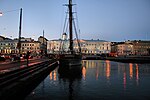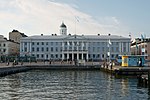Crisis Management Initiative
2000 establishments in FinlandMartti AhtisaariPeace organisations based in FinlandResearch institutes in FinlandResearch institutes of international relations ... and 2 more
Think tanks based in FinlandThink tanks established in 2000
CMI - Martti Ahtisaari Peace Foundation is an independent Finnish non-governmental organisation that works to prevent and resolve conflict through informal dialogue and mediation. Nobel Peace Prize laureate and former President of Finland Martti Ahtisaari founded CMI in 2000. CMI has offices in Helsinki and Brussels as well as a presence in selected countries. CMI transformed from an association to a foundation on 1 May 2021. The organisation is officially registered as CMI - Martti Ahtisaari Peace Foundation sr.
Excerpt from the Wikipedia article Crisis Management Initiative (License: CC BY-SA 3.0, Authors).Crisis Management Initiative
Eteläranta, Helsinki Kaartinkaupunki (Southern major district)
Geographical coordinates (GPS) Address Nearby Places Show on map
Geographical coordinates (GPS)
| Latitude | Longitude |
|---|---|
| N 60.165904 ° | E 24.9523 ° |
Address
Galleria Sculptor
Eteläranta 12
00130 Helsinki, Kaartinkaupunki (Southern major district)
Finland
Open on Google Maps











